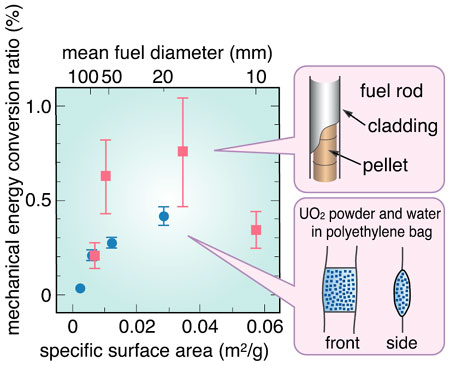Extending the utilization period of reactor fuel, designated "burnup extension," has been promoted worldwide for efficient use of uranium resources, reduction of fuel cycle cost and other reasons. Burnup extension, however, may degrade fuel integrity due to cladding corrosion and undesirable changes in fuel states. Thus, the safety of high burnup fuel must be confirmed under accident conditions as well as in normal operations. To evaluate the influence of fuel failure on reactor safety, experiments simulating Reactivity Initiated Accidents (RIAs) are being performed in the Reactor (NSRR). In addition to high burnup fuel experiments, separate-effect tests were performed with unirradiated uranium dioxide (UO2) powder that simulated fuel fragment dispersion into the coolant, which is expected to occur in failures of high burnup fuel (Fig. 3-1).
The powder fuel tests showed that energetic steam generation could arise from fuel/coolant thermal interaction, when fuel fragments having a large surface area were quickly dispersed into the coolant. Further, the conversion ratio from thermal to mechanical energy in this process depends on the fuel fragment sizes (Fig. 3-2). A similar tendency and conversion ratios were obtained from high burnup fuel tests. Consequently, the mechanical energy generated during high burnup fuel failure under RIA conditions was confirmed to be caused by the fuel-fragment/coolant thermal interaction, not by the ejection of fission product gases from the fuel rods.
|

